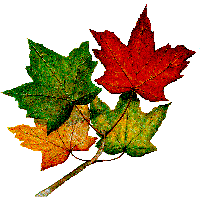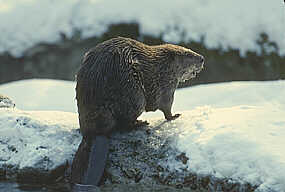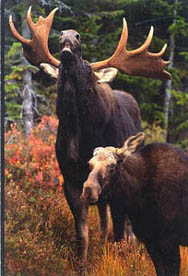
|

|
The Maple Tree
Trees have played a meaningful role in the historical development of Canada and continue to be of commercial, environmental
and aesthetic importance to all Canadians. Maples contribute valuable wood products, sustain the maple sugar industry and
help to beautify the landscape. Maple wood, which varies in hardness, toughness and other properties, is in demand for flooring,
furniture, interior woodwork, veneer,small woodenware, and supports several flourishing industries in eastern Canada. Maple
is also highly prized in furniture building and cabinet-making. Since 1965, the maple leaf has been the centrepiece of the
National Flag of Canada and the maple tree bears the leaves that have become the most prominent Canadian symbol, nationally
and internationally. Maple leaf pins and badges are proudly worn by Canadians abroad, and are recognized around the world.
Although the maple leaf is closely associated with Canada, the maple tree was never officially recognized as Canada's
arboreal emblem until 1996.
Many Canadians in the forest sector have long requested that the Government select
the maple tree as Canada's arboreal emblem. They now enjoy the use of the maple tree as an official symbol when promoting
Canada as a world leader in sustainable forest management.
It is the generic maple species that is being proclaimed
as Canada's arboreal emblem. Of the 150 known species of maple (genus Acer), only 13 are native to North America. Ten of these
grow in Canada: Sugar, Black, Silver, bigleaf, Red, Mountain, Striped, Douglas, Vine and the Manitoba. With the exception
of four species, native maples are large trees. At least one of the ten species grows naturally in every
province.
All provinces have established arboreal emblems and this emblem is an important element within the family of national
symbols.
The maple tree was officially proclaimed national arboreal emblem of Canada on April 25, 1996. It was
published in the Canada Gazette on May 15, 1996.
The Maple Leaf

Before the coming of the first European settlers, Canada's aboriginal peoples had discovered the food properties of maple
sap, which they gathered every spring. According to many historians, the maple leaf began to serve as a Canadian symbol as
early as 1700.
In 1834, the first St. Jean Baptiste Society in North America made the maple leaf its emblem.
In 1836, Le Canadien, a newspaper published in Lower Canada, referred to it as a suitable emblem for Canada.
In
1848, the Toronto literary annual The Maple Leaf referred to it as the chosen emblem of Canada. By 1860, the maple leaf was
incorporated into the badge of the 100th Regiment (Royal Canadians) and was used extensively in decorations for the visit
of the Prince of Wales that year.
Alexander Muir wrote The Maple Leaf Forever as Canada's confederation song in
1867; it was regarded as the national song for several decades. The coats of arms created the next year for Ontario and Quebec
both included the maple leaf.
The maple leaf today appears on the penny. However, between 1876 and 1901, it appeared
on all Canadian coins. The modern one-cent piece has two maple leaves on a common twig, a design that has gone almost unchanged
since 1937.
During the First World War, the maple leaf was included in the badge of the Canadian Expeditionary
Force. Since 1921, the Royal Arms of Canada have included three maple leaves as a distinctive Canadian emblem. With the proclamation
of Canada's new flag in 1965, the maple leaf has become the most-prominent Canadian symbol.
In 1939, at the time
of World War II, many Canadian troops used the maple leaf as a distinctive sign, displaying it on regimental badges and Canadian
army and naval equipment.
In 1957, the colour of the maple leaves on the arms of Canada was changed from green
to red, one of Canada's official colours.
On February 15, 1965, the red maple leaf flag was inaugurated as the
National Flag of Canada.
|

|

|

|

|
The Beaver
BEAVER!!!

Description - This very large, dark brown rodent has a black, scaly tail which is horizontally flattened and paddle shaped
and used as a rudder while swimming , as a sturdy support on land and for balance when the beaver carries heavy tree branches
or building materials in its front paws. The back feet are large, webbed and black; the eyes and ears small; incisors are
very large and chestnut coloured. Average weight is 45-60 pounds but they have been recorded at up to 110 pounds.
Distribution
- The beaver occurs throughout most of Canada and all of British Columbia in rivers, streams, marshes, lakes and ponds.
Biology - The beaver builds its lodge out of intertangled twigs and sticks; as freezing weather nears they plaster the
lodge with mud making a concrete layer that no predator can break through. Predators include coyotes, wolves, bears, lynx,
and wolverines; mink, hawks and owls will also take some kits.In late April to early July 3-4 kits are born. The beaver is
highly adapted to its aquatic life with
webbed hindfeet, the rudder-like tail, valves that close off the ears and nostrils,
skin flaps that seal off the mouth but leave the incisors free for underwater gnawing and carrying and clear membranes that
slide over the eyes protecting them from floating debris. During the early nineteenth century the beaver pelt was the single
most valuable commodity; the pelt being used for robes, coats, clothing trims, and top hats. Nowadays the pelt is still highly
valued, the flesh and sometimes,the tail are considered tasty but the beaver is now protected from over- trapping.
The Moose
"Dolores! You made
STINK!"

Description- This horse-sized animal is the largest member of the deer family with long, dark brown hair, high, humped shoulders
and long legs. A pendant of hair-covered skin sometimes reaching 2 feet hangs under the throat. Each April the male moose
or bull grows a set of antlers reaching 120-150 cm which he loses in the winter after rutting season.
Distribution
- The moose occurs in spruce forests, swamps, aspen and willow thickets; it is built to live in rough country and is well
adapted to a cold climate.
Biology - The rut lasts from early September to late October and 8 months later 1-2 calves
are born. Moose are unpredictable and sometimes dangerous; although they generally avoid human contact, cows with calves and
rutting bulls have been known to charge people, cars, horses and locomotives.
(I would like to mention, as a side
note, that during the rut, bulls make a depression in the ground to urinate into. The cows then roll in the bull's urine.
They enjoy this SO much, sometimes they don't wait for the bull to finish urinating, and fights often break out between the
cows over who gets the bull's urine!)<-- This lovely bit of information brought to you by your friendly neighbourhood Anatole.
The Canada Goose
Remember, all geese
have reticulate tarsus.

Geographic Range
Nearctic: Canada Geese are found throughout North America. The specific areas in which these bird are
found depends on the subspecies. These geographic locations can be divided into four groups; the Southern, Northern, Western
and Aleutian-Canada populations. The Southern population ranges from 60 degrees North latitude to the Rockies and Atlantic.
The Northern population ranges north of 60 degrees North latitude in the arctic and subarctic. They then travel to the
southern parts of the United States during the winter. The Western population is found in the eastern coasts of Alaska and
British Columbia. Lastly, the Aleutian-Canada population is rarely found. A general trend in all subspecies is that they
all summer in the northern parts of North America in Canada and migrate south to areas of the United States in the winter
months.
Physical Characteristics
Mass: 1 to 4 kg.
Branta canadensis have a black neck, bill and
head with occasional white patches and a white strap under the chin. The body is usually brownish-gray although colors vary
in some of the subspecies. In some of the smaller subspecies the body is dark brown in color where as in some of the larger
subspecies, the body is a light gray tone. Underneath, the colours are much lighter and almost white on the tail. During flight
the tail shows a white semi-circle just above the black tail. These colour patterns are unique to the Canada Goose. Females
may be slightly smaller than the males, although both are similar to each other in
colour pattern. The bill of Branta
canadensis tapers from the base where it is high to the end where it has narrowed. The bill has lamellae, or teeth around
the outside that are a used as a cutting tool. The legs are close together with very black feet. This goose has very large
wings that can also be used as weapons.
The weight of Branta canadensis also varies depending on the subspecies.
There are larger subspecies that weigh about 9 pounds and smaller subspecies that only weigh 3 pounds.
Goslings,
or baby Canada Geese, are yellow with some greenish-gray colourings on the top of the head and back. As with the adult colour
pattern, there are some variation among the different subspecies. The darker subspecies goslings have a brownish olive or
blunt yellow colouring while those of lighter subspecies are lighter and brighter in colour. These colours fade as the gosling
grows into the adult colour pattern. All goslings have black or blue-gray bills and legs and become darker as juveniles and
adults.
Natural History
Food Habits
When on land, Branta canadensis eat a variety of grasses
including Bermuda grass, salt grass and wild barley. Geese are able to grab a hold of each blade and pull it out with their
bills by jerking their heads. They also eat wheat, beans, rice, and corn. In the water, the birds stick their head and upper
part of their body into the water leaving their tail and back end extending in the air. They stretch their neck out, under
the water, and slide their bills across the bottom silt. They also eat a number of aquatic plants such as eel grass, sea lettuce
and sago.
Reproduction
Females start laying eggs during the first weeks of March and continue as late as June
in parts of the Arctic. Each egg takes a day and a half to be laid. The average clutch sizes are five eggs although this size
ranges from 2 to 9 eggs. The incubation period lasts 25 to 28 days. The female incubates the eggs while the male protects
the territory and stays nearby to call a warning if danger approaches.
Incubation must occur immediately after the
last eggs are laid. The female turns the eggs regularly to maintain the
heat necessary to allow for hatching. The offspring
hatches via an egg tooth on top of its beak to crack open the shell. Goslings keep cracking open the shells until they are
completely free between 24 and 48 hours later. All of the eggs in the clutch are fully hatched with in 24 hours. The goslings
with in a clutch usually have a sex ratio that is fifty-fifty.
Behavior
Males in this species are more aggressive
than females. The bills are used not only for eating, but also in attacks and grooming. These birds take to flight when danger
approaches. They also lay out flat and still on the ground with their necks stretched out to be less visible to the danger.
Canadian Geese have good eyesight, which is necessary for flight. They must move their heads in order to see out
of their eyesight range. However, their eyes are close to their crowns on the side of their heads, enabling them to see more
than 180 degrees (closer to 270 degrees) horizontally and vertically. They have mostly monocular vision. Canadian Geese have
excellent hearing and the ears are located on the side of its head.
During warm days of the year, geese flatten
their feathers against their body to reduce the dead air space and keep them cool. On cold days, they fluff their feathers
to increase their insulating ability. They are seldom found alone and communicate constantly with many sounds. They fly in
flocks in the form of a "V" or a diagonally straight line to minimize the effort for the birds following the leader.
Each bird doesn't fly directly behind the others, but off to an angle. They migrate at a slow pace, stopping along the way.
Because of this pace, they arrive at the breeding grounds in good physical shape. Most geese mate for
life. They form
pairs during migration or on wintering grounds. Males fight over females with their wings and bills. The winner approaches
the female with his head down and neck undulating. He makes hissing and honking noises. The pairs mate either before or after
they have found a nesting location. Mating, occurs in the spring on the water. The female is usually partially submerged or
completed submerged while copulation takes place. Older geese tend to return to the same breeding territory each year. The
female chooses the location for nesting and even builds the nest without the male. The males defend the territory, nest, and
eggs from intruders, such as other geese. The female has to leave the nest to eat, rest, swim and preen. Unguarded nests and
eggs are targets for predators such as gulls, ravens, crows, skunks, dogs, and many others. The male sends out an alarm by
flying into the
air and honking as a predator approaches. This alerts not only his mate but others nesting nearby. Females
lower their bodies onto the nest and stretches out their necks to camouflage the nest. After the eggs hatch, the family group
(the offspring and parents) leave the nest for good and start to travel to their summer locations.
These birds love
to swim and bathe in the water, especially on warm days. The Geese swim and flap around and sometimes completely submerge
themselves.
Some subspecies have a yearly molt of flight feathers in the summer and become flightless during this
time.
Migrations begin in the fall. Large winter aggregations form while on lakes, coastal waters, and mudflats.
Habitat
When females pick a nesting site, they look for a place that has good visibility but is still isolated
so they have a warning of danger and protection if danger approaches. The area also must have open water with low banks so
they can have access to aquatic plants. Places such as swamps marshes, meadows, lakes, and other such places are among some
of the favourite nesting areas. Canadian and Alaskan shorelines have tundra that provides an adequate nesting site. Branta
canadensis are seen nesting on small islands that don't have very tall grasses or in Muskrat houses
(which are similar
to small islands).
Nests are very simple and are made quickly. Materials that are used are weeds, twigs, grass,
moss, needles, and other such materials. After some collection and building, she rounds out a curve or depression with her
body. She drops the materials around her and moves the items to get the best fit. From time to time she rounds out the center
with her chest or feet. If there are no items of vegetation the nest may only be a depression in the ground shaped by her
chest and feet.
Once the eggs are laid, the nest is lined with feathers and down. Down insulates against extreme
warmth as well as cold, stabilizing egg temperature.
If you really feel you need to know more about Canada, and its symbols, click in the link below.
Canadian Symbols
|

|

|

